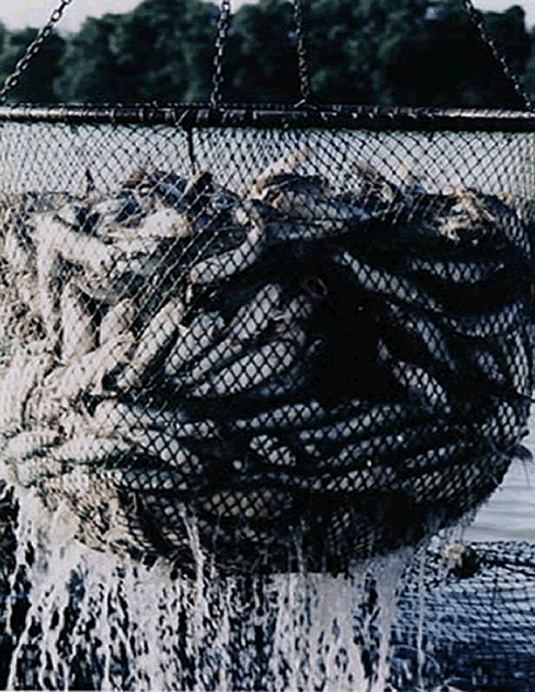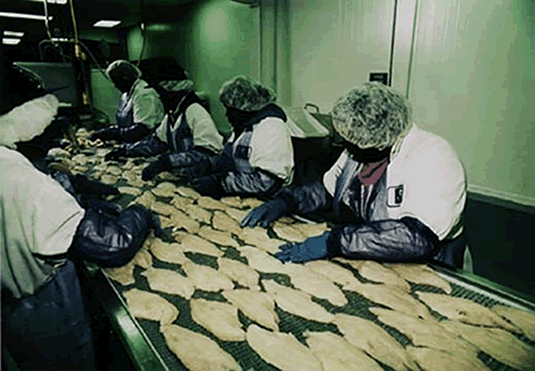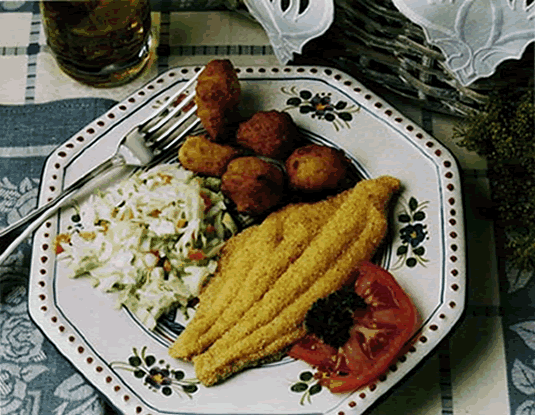Farm-raised catfish is the largest aquaculture industry in the United States. In 2005, the U.S. catfish industry produced 600 million pounds of catfish from 165,000 pond water acres. The farm-raised catfish industry at $450 million in annual production value has the highest economic value of any aquaculture industry in the United States. The next highest valued aquaculture industry in the country is trout, valued at $74 million in annual production.
Mississippi produced 350 million pounds, or 55 percent, of all U. S. catfish production in 2005, and Mississippians produced this amount in only 100,000 pond water acres. Since its origin in the 1960s, the catfish industry has grown rapidly and now has an economic impact in the hundreds of millions of dollars in Mississippi each year.
Arkansas, in 1963, was the first state to produce farm-raised catfish on a commercial level. Mississippi was not far behind when its commercial production began in 1965. After 1970, rapid expansion of catfish production in the Mississippi Delta occurred, and Mississippi has led the catfish industry ever since.
Growing the catfish
Channel catfish, which is ideally suited to a pond environment, quickly became the standard species for commercial use. These fish are hardy, tolerate dense stocking, and thrive in a wide range of environmental conditions. They are easily spawned under proper conditions, yet will not spawn when placed in the grow-out ponds, which gives the farmer control over the production process. Fish newly hatched from the egg, called fry, readily accept manufactured feed and continue to eat feed until they are harvested at a weight of one to three pounds. The catfish’s most important asset is its good taste which drives the demand for this healthy food. The white channel catfish flesh is firm with a mild flavor allowing it to be prepared and seasoned in a number of ways, such as fried, broiled, grilled, or baked.
Before catfish were produced in ponds, Mississippians supplied their kitchens and their fish-fry events by either catching their own catfish in nearby rivers using cane poles, or buying catfish from fishmongers or commercial fishermen. Restaurants serving catfish have always been popular in Mississippi and require lots of catfish. At times commercial catfish fishermen could not supply enough wild-caught river catfish and pond-raised catfish began to fill the need. Over time the consistent quality and quantity of pond-raised catfish produced by farmers was preferred over the commercial fisherman’s wild-caught river catfish.
Mississippi had many early pioneers in the farm-raised catfish industry who came from a variety of backgrounds. Many of them entered into the catfish industry because they were looking for crop diversification or for profitable alternatives to growing cotton on marginally productive lands, while others entered the business because of the novelty of growing fish in a pond as a crop.
Catfish farming practices have changed since the days of the early pioneers. In the 1960s, catfish ponds ranged from twenty to forty acres while today the typical pond has been reduced to ten to fifteen acres because it is easier to manage, feed, and harvest catfish from smaller ponds. Catfish harvesting and loading methods have changed as well. In the 1960s farmers entered the drained pond with wash tubs, loaded the tubs with fish, and carried them up the pond embankment. The fish would be weighed on cotton scales and then lifted up and dumped into the back of a hauling truck. Today seine nets are used to capture the fish, without draining the ponds, and cranes equipped with scales hoist large nets full of catfish from the pond directly to truck hauling tanks, making the whole process much easier and quicker.
Growth of the industry
In the early days catfish farmers would spend hours on the telephone making contacts to sell their fish. They sold mainly to restaurants specializing in catfish, but they also sold to individuals wanting 5,000 pounds or more for fish fries. Winter sales to fish camps were also an important sales outlet. Catfish were in demand and were sold to buyers as far away as Illinois and Iowa. Selling the fish also meant transporting them live in live-haul trucks equipped with aerators that provided oxygen to keep the fish alive.
Today, most Mississippi catfish operations sell all their catfish directly to processing plants and no longer have diverse retail outlets. Early processing plants in Mississippi include Farm Fresh, which opened in Hollandale in 1978 (closed in 2002), and Delta Pride Catfish Incorporated which opened in Indianola in 1980 and is still in operation. In early 2006 Delta Pride and Country Select Catfish in Isola formed Consolidated Catfish Producers LLC to handle sales, marketing, and distribution for both companies.
In the early 1970s two trade associations for catfish producers were organized with the help of then Commissioner of Agriculture and Commerce Jim Buck Ross. The Catfish Farmers of America (CFA) and the Catfish Farmers of Mississippi worked together to share ideas, solve industry problems, and to present a unified voice when representation of the industry was required.
One early problem the producers faced was catfish feed. Catfish producers initially bought feed from many different suppliers, often with disastrous results because feed companies did not know the nutritional requirements for catfish. In one 1973 case when the price of the main catfish feed ingredient, soybean, increased dramatically, feed mills substituted the lower cost cotton seed meal. Catfish cannot use the nutrients in cotton seed meal, and failed to grow. Producers knew then they could not depend on distant feed mills; they needed to start a local feed mill to make special feed for raising catfish. In 1976, ten producers joined with the Mississippi Federated Cooperatives to form Producers Feed Mill in Belzoni. Belzoni, located in Humphreys County, calls itself the Catfish Capitol of the World and stages its Catfish Festival every year in April.
Mississippi State University was the first institution to conduct research on the nutritional requirements of catfish. University researchers determined the correct protein, carbohydrate, energy, vitamin, and amino acid requirements for catfish and developed a well-balanced feed formula for catfish.
Another challenge that was discovered in the mid-1970s was described as “off-flavor” in catfish, an earthy odor that was a by-product of intensifying fish production. Much research has gone into ways to reduce this problem with some success, but it remains an industry challenge. Until a solution is found, all catfish going to the processor are taste-tested for off-flavor before being accepted into the processing plant.
A great evolution in processing occurred in the 1980s when hand filleting of catfish became automated. The result was an enormous increase in the amount of catfish fillets that could be processed in a day. Also in the 1980s, service companies began developing special harvesting boats, nets, and gear while other companies developed electric- or tractor-powered paddlewheel aerators. These products were helped by the Catfish Farmers of America, along with the Catfish Farmer Associations of Mississippi, Alabama, Arkansas, and Louisiana which hold an annual fish farming trade show in Greenville, Mississippi, to sell standard products and to feature new products used to grow catfish.
Marketing U.S. catfish
The Catfish Farmers of America addressed the important issue of ways to increase the markets for farm-raised catfish. It was one thing to make telephone calls to sell three to four million pounds of fish as farmers did in the early 1970s, but it was a different challenge to market twenty to fifty million pounds of catfish that was produced in the 1980s. Ultimately, the CFA created The Catfish Institute in 1986 to advertise and market the U.S. farm-raised catfish product.
With the high profile that comes from its record as the largest aquaculture industry in the United States, the catfish industry has had to protect its market. In early 2000 two things happened that would change the course of the U.S. catfish industry. First, catfish producers were receiving the highest price they had ever received for their product, and this high price attracted attention from sellers of potential substitute products. Secondly, “basa” and “tra” fish importers, mainly from Vietnam, had no luck selling their fish product in the United States under such names as “White Roughy” and “River Cobbler.” However, when fish importers began calling their fish “catfish,” their sales picked up immediately. In a span of eighteen months, Vietnamese frozen “basa” and “tra” fillets replaced over 23 percent of the small catfish fillet market previously held by U.S. catfish processors. The CFA protested this misrepresentation of the foreign product to consumers.
The CFA consulted with its members, congressmen, and attorneys to determine what could be done. After months of deliberation two actions were initiated. First, they secured the introduction of a bill in the U.S. Congress stating that only channel catfish (Ictalurus punctatus), a native North American catfish, could be called “catfish” for marketing purposes in the United States. Thus “basa” and “tra” from overseas waters cannot legally be identified as “catfish” in the United States.
The second action taken by the CFA was to hire attorneys specializing in anti-dumping cases to investigate whether the imported “basa” and “tra” production was subsidized by the Vietnamese government. If so, this would amount to Vietnam selling its product in the United States at a price below the “fair market value.” The Catfish Farmers of America would then have an anti-dumping case to present to the U.S. Department of Commerce’s International Trade Commission (ITC). The ITC is the federal trade agency that investigates claims of “dumping,” or the practice of selling a product at a lower price than what it costs to produce it. This dumping occurs when governments subsidize or in some way pay for some of the production costs that producers otherwise would have to pay themselves. The government subsidy gives the company an unfair advantage because the company can sell at a lower price and make more sales and profits than a company that must pay these costs and as a consequence have lower profit margins.
The investigation found evidence of foreign government subsidies, and the CFA filed an anti-dumping case with the ITC. After almost two years of fact-finding and deliberation, the ITC ruled in favor of the Catfish Farmers of America and placed countervailing duties (tariffs) on a handful of Vietnamese fish importers. This decision was a major victory for U. S. catfish producers because it “raised” the price of imported “basa” and “tra” fish products by 37 percent to 64 percent; that is, to a price level similar to U.S. farm-raised catfish costs.
In the long run, however, global seafood imports and the competition posed to the U.S. catfish industry will not abate. In 2004, the U.S. Congress implemented a new program since the ITC’s anti-dumping ruling that targets all seafood products. This COOL, or Country of Origin Labeling, legislation has provisions that all seafood retailers in the United States, except in food service establishments, must mark fish and shellfish products as either farm-raised or wild-caught and identified as to the country of origin. In early 2006 it is still unclear how COOL will affect the U.S. farm- raised catfish industry, but the industry believes it will give the U.S. consumer additional information upon which to base their decisions when buying seafood.
The U.S. catfish industry believes it has a good-tasting product and thinks those who have eaten U.S. farm-raised catfish will rely on the COOL label to ensure that they are again buying the U.S. farm-raised catfish product.
Terrill R. Hanson, Ph.D., is an associate professor of agricultural economics at Mississippi State University.
Lesson Plan
-

Aerial view of catfish ponds in Humphreys County, the county with the most water acres in catfish production in Mississippi — 20,600 water acres in 2005. Photo courtesy The Catfish Institute. -

Catfish feed types. Upper row shows three types of finely ground, nutritionally complete feed that are fed to newly hatched catfish, called “fry.” Bottom row from left to right: 1/8" and 1/4" floating catfish feed fed to fingerlings and adult catfish, and sinking catfish feed used during winter months. Photo courtesy Dr. Terrill R. Hanson, Mississippi State University.
-

An electric 10-horsepower aerator increases the oxygen level in pond water. Photo courtesy Dr. Terrill R. Hanson, Mississippi State University. -

A Mississippi Delta catfish harvest scene. A tractor pulls one end of a seine net to corral catfish toward one end of the pond. Photo courtesy Dr. Terrill R. Hanson, Mississippi State University. -

A basket of harvested catfish is hauled from a Mississippi Delta pond to a transport truck container. Photo courtesy The Catfish Institute. -

Workers at a Mississippi catfish processing plant lay catfish fillets flat before the fillets enter a quick-freeze tunnel. Photo courtesy The Catfish Institute. -

Classic fried catfish. Photo and recipe courtesy The Catfish Institute. Recipe for Classic Fried Catfish: 3/4 cup yellow cornmeal, 1/4 cup all-purpose flour, 2 teaspoons salt, 1 teaspoon cayenne pepper, 1/4 teaspoon garlic powder, 4 U.S. Farm-Raised Catfish fillets, Vegetable oil for frying. 1. Combine cornmeal, flour, salt, cayenne pepper, and garlic powder. Coat farm-raised catfish with mixture, shaking off excess. 2. Fill deep pot or 12-inch skillet half full with vegetable oil. Heat to 350°F. Add catfish in single layer, and fry until golden brown, about 5 to 6 minutes, depending on size. Remove and drain on paper towels. 3. Enjoy!
References:
The Catfish Institute at: https://www.uscatfish.com/
Farm Security and Rural Investment Act of 2002. Text of Statutory Language as Submitted to the U.S. House of Representatives and U.S. Senate from the Committee of the Conference, Subtitle D - Country of Origin Labeling, sections 281 - 285, May 1, 2002.
Tucker, C.S. and Hargreaves, J.A., eds. “Industry Development,” in Biology and Culture of Channel Catfish, 1-14. Amsterdam, The Netherlands: Elsevier Science Publishers, 2004.
U.S. Department of Agriculture, National Agricultural Statistics Service (NASS). “Catfish Processing,” Washington, D.C., various issues.
U.S. Department of Agriculture, National Agricultural Statistics Service (NASS). “Catfish Production,” Washington, D.C., various issues.
U.S. Department of Agriculture, National Agricultural Statistics Service (NASS). “2002 Census of Agriculture,” Washington, D.C., 2004.
U.S. Department of Agriculture, National Agricultural Statistics Service (NASS). “Trout Production,” Washington, D.C., released February 24, 2006.
